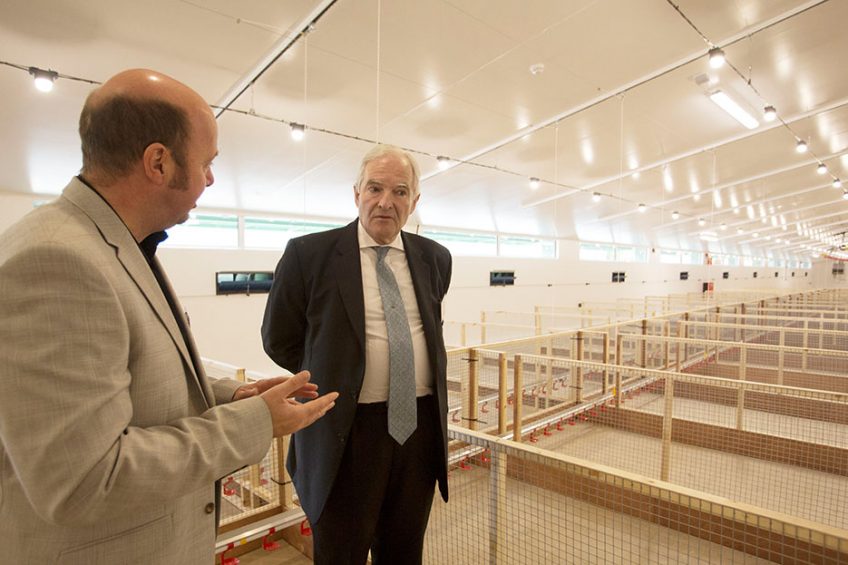Scotland is a pioneering place for poultry

Scotland is arguably established as one of the world’s best spots for avian research. Poultry World rounds up some recent developments and finds three reasons that make Scotland a pioneering place.
On a nondescript estate just outside Edinburgh, Scotland, you can find some of the world’s most advanced research facilities for livestock, The Roslin Institute, and it is far from the only facility in the country working to improve poultry research. Aviagen has its headquarters nearby and breeding facilities in the country, as do other genetics firms. And a new research centre opened its doors in early June that is thought to be the largest of its kind. It is worth considering the geography of Scotland for a moment. As a developed country it has good transport access but is relatively remote when compared with the rest of Europe, making it good for biosecurity. And as facilities have sprung up over time, it has made sense to build other research centres close by, to take advantage of potential collaboration. Here are three reasons a poultry research should consider Scotland as the place to be.
The Allermuir Avian Innovation and Skills Centre
This centre, which replaced an older research facility in Auchencruive, close to Glasgow, represents a £5.6m (€ 6.2m) investment in poultry science. It is primarily a trial facility for feed and behaviour studies into broilers, layers and turkeys, and the 144-pen research room is thought to be the largest of its kind in Europe. It also has windows, common to many poultry farms in Europe today. The site also has smaller rooms for behavioural trials, a replica small-scale colony egg production unit and other trial facilities.
It is close to research facilities at Scotland’s Rural College’s (SRUC) Bush Estate and Easter Howgate campuses. It is also close to the Roslin Institute which is pioneering genetic research into poultry. Jos Houdijk, who runs the facility, says: “One of the big advantages we have is that, being so close to other research centres we will be able to achieve synergies that can’t be replicated elsewhere.” Once fully operational about 30-35 people will work on the site. A small slaughterhouse is also being built in partnership with Aviagen on the site. About 70% of the trial work will be for commercial clients, according to the site’s team leader Prof Houdijk. He added that, of those trials, more than half would be related to feed-additive studies that examine the impact of different products on gut health.
The first research projects will look at novel antimicrobials impacts on performance and gut microbiome, and the role of amino acid nutrition on gut health. Speaking at the opening of the event, the SRUC’s principle and chief executive Professor Wayne Powell said: “The Allermuir Avian Innovation and Skills Centre will be of huge benefit to Scotland, the United Kingdom and globally. The people and facilities based here will help attract research investment from across the world. “CIEL and Innovate UK are excellent partners in the project and I’d also like to thank the Scottish Funding Council for its support.
“A future with industry, researchers and governments working in closer collaboration is how we will meet the global challenges facing society. “Partnerships like Allermuir Avian Innovation and Skills Centre is the model we need to take to support growth the economy.”
The UK’s Centre for Innovation Excellence in Livestock invested £1.9 million (€ 2.1m) in the new centre, with funding from Innovate UK, the UK’s innovation agency. SRUC invested £3.6 million (€ 4m) with support from the Scottish Government’s Funding Council’s Financial Transactions Programme.

The Roslin Institute’s pioneering work to breed birds resistant to bird flu
Ongoing work at the Roslin Institute is to gene-edit poultry to potentially prevent birds from spreading avian influenza. And the latest success in this long-running project has been to gene-edit chicken cells to prevent them from spreading the virus. Researchers have been able to target a specific molecule inside chicken cells called ANP32A, which the influenza virus takes over to help replicate itself. The work was a collaboration between Roslin and Imperial College London. After removing the section of DNA responsible for producing ANP32A, the virus was no longer able to grow inside cells with the genetic change. The research was conducted last year and published recently in the journal eLife. It was funded by the UK Government’s Biotechnology and Biological Sciences Research Council, with additional support from Cobb Vantress.
Researchers at the Roslin Institute previously worked with experts from Cambridge University to produce chickens that did not transmit bird flu to other chickens following infection, using genetic modification techniques. The new approach differs because it does not involve introducing new genetic material into the bird’s DNA. The Roslin Institute’s Dr Mike McGrew said: “This is an important advance that suggests we may be able to use gene-editing techniques to produce chickens that are resistant to bird flu. “We haven’t produced any birds yet and we need to check if the DNA change has any other effects on the bird cells before we can take this next step.” “We have long known that chickens are a reservoir for flu viruses that might spark the next pandemic,” added Wendy Barclay, chair in influenza virology at Imperial College London. “In this research, we have identified the smallest possible genetic change we can make to chickens that can help to stop the virus taking hold. This has the potential to stop the next flu pandemic at its source.”
Aviagen updates performance guidelines
Just up the road from the Roslin and Allermuir research facilities is Aviagen’s headquarters, and it was recently able to update its global performance guidelines. The updated guidelines now suggest a target FCR for birds grown to 2.5kg of 1.53, down from 1.62 in its previous performance objectives. Breastmeat yield is also up 2.08% to 23.68%. Aviagen said the targets reflected “continued genetic improvement” and could be achieved in the field under good management conditions. The firm also issued new nutrition guidelines, but recommendations remain unaltered from those made in the company’s 2014 update.
 Beheer
Beheer




 WP Admin
WP Admin  Bewerk bericht
Bewerk bericht